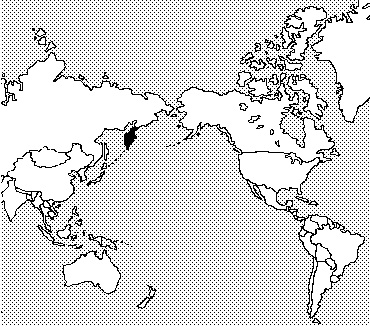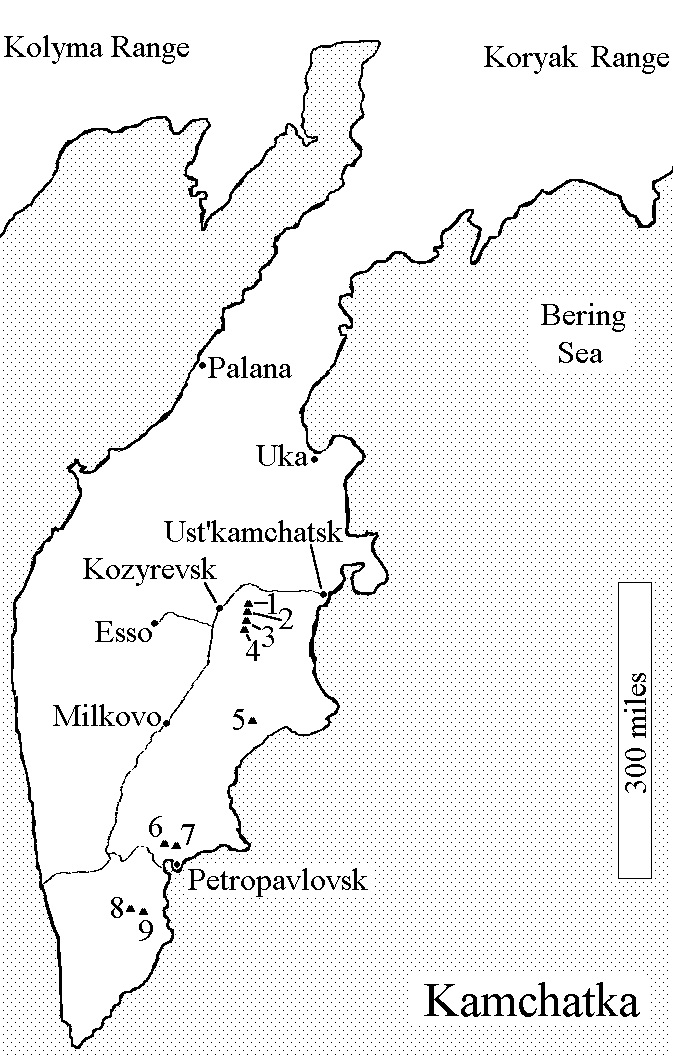Kamchatka
David Laughton
Kamchatka is that elongated, pear shaped peninsular dangling from the N.E. corner of Russia above Japan. Situated on the Pacific “Rim of Fire” it is extremely volcanic with ice clad peaks rising to almost 16,000 ft. Until four years ago no foreigners, nor ordinary Russians were allowed there. The main city is Petropavlovsk, situated on Avachinska Bay, one of the finest natural harbours in the world and an important Russian naval base.
Ever since I first saw that brilliant TV series “Realm of the Russian Bear” I have wanted to visit Kamchatka and eventually found a suitable looking package run by a company called Exodus, going there for three weeks in August, 1994. A three hour flight by B.A. brought our party of nine to Moscow (3 hour time change), a hair-raising drive across the centre of town and some 20 miles further south to one of the other airports then check-in for a nine hour overnight flight by Aeroflot, due east with a further nine hour time-change. We arrived at Petropavlovsk early afternoon to be met by our young fit English leader, who had just led a 3 week trek in the Altai Mountains and by our transport. This was a 6-wheel drive Ural truck comprising cab and bus body with some 16 forward facing seats. Gear loaded, we repaired to one of the few hotels in town, good when built but now rather run down, for a much needed sleep. We learnt that our party of 10 would be supported by a driver, two “guides”, a gook and an interpreter; four of them local, one from Moscow.
After spending a full day in P.P. seeing the town and its excellent museum we headed North in our truck first on metalled, then dirt roads and finally down a very narrow, muddy track along the banks of the Kamchatka River to find a campsite. This first day not only showed the versatility of our truck but also introduced us to one of the major problems of the holiday -mosquitoes. Before long the truck windows were almost covered with squashed mossies as were our tents into which we retreated rapidly once up, even a smoky fire did little to keep us free. On getting up next morning, sleeping bags damp with a heavy dew and too small tents, we were intrigued to find the footprints of a large bear across a mud bank just below our camp site. Unfortunately this and some later indistinct prints were all we saw of the famous Russian bears.
Another longish drive, still heading North gave us superb views of the high peaks we were aiming for crystal clear in the pure air. Our aim was to a camp high for three nights in an area covered by ash from a huge volcanic eruption in 1976 and, if possible, to climb up to the crater of one of the group of volcanoes, Tolbachic, at around 10,000 ft. The highest nearby peak at 15,800 ft was way beyond the capabilities of our party and would be a major expedition, particularly in view of the problems associated with active volcanoes. I have since learned that a British party reached the summit of Klivchovskoi a few weeks before our visit and that there was a spectacular eruption shortly after we left.
Our vehicle soon proved its worth when the rough track we were now following ended in a 6 ft drop cut by recent floods. We got out, the driver engaged 6 wheel drive and rove down it with no problem, crossed the wide, rock strewn river bed and climbed an equally high and sheer bank on the other side. Then up over ash, lava and snow fields to our camp site amid a dead forest of large birch trees which had not been able to survive the few feet of ash deposited by the 1976 eruption. Although the site was bleak, without water and very cold (at some 3,000 ft) we could have large wood fires on each of the three nights spent there. Happily there were no mossies, only a small vole to keep us company. Whilst up there we explored the area on foot, descending through scrub, lava and mud to a 259 yard long lava tube just high enough to crawl through and climbing a series of high cinder cones one still warm enough to provide a cozy lunch spot. Unfortunately on the day of the planned ascent to the main crater it poured with rain and the clouds covered the mountain so we walked elsewhere.
A different route took us back to our riverside camp for one night to find the insects worse than ever. Next morning we were picked up by helicopter for a magnificent flight in perfect weather over the tundra like plateau, then over another group of volcanoes giving spectacular views down into the craters. We were put down in a beautiful area some 30 miles from P.P. where there are hot springs and a few cabins catering for people who walk or helicopter in – there is no road or track. We camped there amongst birch and alder trees for four nights each day walking through the forests and up to hot springs, mineral pools or view points all the time under the gaze of a couple of magnificent, gleaming, ice encrusted peaks. On the fifth day we were helicoptered out flying between the two teaks, again in perfect visibility.
After a night recuperating in the P.P. hotel we were reunited with our truck for a long drive S round Avachinska Bay and up increasingly bad roads around the boot of yet another volcano to a beautiful campsite beside a small stream with a grove of alder bushes providing shelter and a profusion of wild flowers. A walk in late afternoon saw us crossing a pass and descending via an impressive waterfall to an old gold mining camp, now trying to establish itself as a XC ski centre and a nearby hot pool in which we soaked. Next day was a big one, an attempt on a volcano (Mutnovsky), quite a distance from camp. We were away by 7.30 for an extremely rough drive. The track had been churned up by geologists and surveyors planning the route of a pipeline from the volcano to
carry hot water and steam to the town below, our Russian friends assured us it would never by built! We eventually reached a large sloping snowfield with a deep, bergshrund like crack below. We walked across, the truck eventually made it by letting down the front tyres (automatically) and reinflating them once across. Long ash slopes, lava fields and more snow were crossed before even our driver admitted defeat in a very rocky, steep stream bed. Our climb now began. The usual mixture of mud, ash, lava and snow led us pleasantly upwards giving ever expanding views over the moonscape¬like surroundings. I got far enough to see into the crater with its serac’d glacier and fumeroles belching steam at regular intervals but a bad knee prevented me going down with most of the others into it. They got back to the truck a couple of hours after me at 7 pm for a two hour drive back to camp. Next day it rained so an early retreat was made, this time to a lodge owned by the Truckers Union some miles outside P.P. The attraction was a nearby swimming pool fed by natural hot water just cool enough to swim in.
|
Our final walking trip was an attempt on Avachinsky, 9,025 ft one of the volcanoes dominating P.P. Again a very rough drive, mainly up the bed of a river obviously regularly flooded with an occasional track, breached in many places. After a couple of hours we reached base camp, a collection of some twenty huts in various stages of decrepitude with a few resident vulcanologists. Fortunately we didn’t need to pitch tents as we were able to get into a couple of the huts, equipped with a sleeping bench. That afternoon we climbed a Suilven like peak up above camp, en-route descending into a large ice cave at the foot of a permanent snowfield. Next day the fit ones planned an ascent of the peak now clearly seen as a huge cinder cone, still active.
Although born in slag heap country and spending much of my childhood running up and down them I am not now daft enough to spend hours slogging up such peaks so decided on a more gentle walk. It soon started to rain and, as the climbers were on the final cone, to snow heavily so they had to retreat some 300 ft below the summit. Another night in our cabins then back to the fleshpots.
After a final day spend sailing around Avachinska Bay, fishing and watching White-tailed and Stellars Sea Eagles we flew back to Moscow for a days sightseeing.
I had found Kamchatka to be an unusual, fascinating area but not feeling as remote as expected. Petropavlovsk is a large town (300,000 population) with an important Vulconology Institute. It seems that staff from this Institute get around into most of the areas on a regular basis thus keeping tracks upon. I feel with a more “reliable” way of getting there (possibly via Alaska, thus avoiding Aeroflot) Kamchatka could become a very popular area for adventure tourism.

